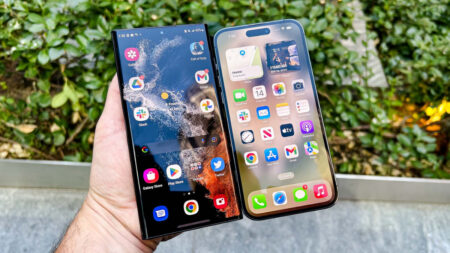OnePlus phones are about to experience significant upgrades. OnePlus CEO and Oppo chief product officer Pete Lau detailed ideas for the future of OnePlus phones during a virtual “Global Media Discussion” with media last week in the hopes of encouraging more transparency with its audience.
He refers to the company’s next phase as “OnePlus 2.0.”
Following the announcement in June that it would further integrate with brother Oppo, with whom it shares the parent company, BBK Electronics, the conversation was much-needed to define OnePlus’ strategy.
While partnering with another company is frequently seen as a positive step toward expansion (read: additional resources), many OnePlus customers have expressed dissatisfaction with the shift.
Depending on how you feel about the tighter OnePlus-Oppo alliance, Lau’s glimpse of what’s coming to OnePlus phones in 2022 is either a bright new beginning or a step toward its death.
“It’s just that currently all eyes are on the two companies and people like comparing the goods and finding a lot of similarities,” Lau said when asked about consumer worries that certain OnePlus and Oppo phones have come to look identical.
However, if you compare a OnePlus phone to a competitor’s device, you may notice even more similarities.” He emphasised that as the person in charge of the two brands’ products, he will work to maintain their individuality.
ColorOS is currently used by Oppo phones, while OxygenOS is used by OnePlus phones. Both operating systems are based on Android, and they share certain UI and UX similarities, but there are some distinctions to be found if you look closely enough.
OnePlus will move its phones from OxygenOS to a new “unified and enhanced global operating system” that will be shared by Oppo devices starting next year with its 2022 flagship — probably the OnePlus 10 (OnePlus hasn’t chosen a name yet). In other words, both companies’ devices will share a single codebase. According to Google, the transition to the new OS will be “finished concurrently with the next major Android update in 2022,” according to Google.
“With our united company, we’ve been able to boost our frequency of updates as well as our R&D resources in order to enable more upgrades on more devices,” Lau said. “And, in particular, delivering four years of security patch updates for our flagship products, in addition to support for three major Android releases.”
If you want to stick with OnePlus, you’ll need to acquire a new phone with a unified OS. Devices that will not receive the unified OS (particular models to be announced later) will still receive any promised OxygenOS software updates as well as four years of security fixes. However, OnePlus will no longer support them once such promises are fulfilled.
“The overall experience of each product can vary significantly. Some goods, for example, may be designed to provide the most high-end or flagship camera experience possible. Others may focus on a unique selfie camera experience, while others may place a more emphasis on the entire gaming experience and performance. So, I believe this has to do with how things are defined, as well as the target demographic for which they are designed. Of course, there’s also the branding and marketing strategy of the various.”

The OnePlus management stated during a conversation on the sidelines of the annual Mobile World Congress in Barcelona that the focus for 2022 would be on performance and charging, particularly the 150w SuperVooc protocol that will be available on the brand’s phones in the second quarter of 2022.
According to the business, the technique would be able to keep the 4,500mAh battery charging at 80% even after 1600 charging cycles.
The business also stated that it would release its most affordable 5G phone this year, geared at the Indian market, but refused to provide further details.
In response to another question about whether the increased number of OnePlus goods will confuse buyers, Lau explained that they now have more items because they aim to appeal to a wider range of customers.
“Right now, we’re extending the product selection and thinking about how we can cater to more individuals with a more specific product positioning,” he stated, emphasising that “less is better” at OnePlus.
OnePlus designers used to work independently from Oppo designers. In the future, Lau believes the teams will collaborate as part of a “bigger overall design team” with more shared resources.
“There are various groups working on OnePlus and Oppo devices within this bigger overall design team.” For our wide product portfolio going forward, as well as the products of the two separate brands, we find that this strategy is the most efficient and successful.”
Marketing, branding, and public relations will all be run independently, according to Lau. “On these fronts, they adopt separate methods.
The OnePlus 9 series will not be available in a “T” version, according to Lau. As a result, there will be no OnePlus 9T or 9T Pro.
The manufacturer has already offered a T version with somewhat improved specifications. The next flagship phone won’t be released until 2022.
OnePlus also said that it is collaborating with Google on “putting new features into foldable devices” – Oppo recently released its first foldable phone, the Find N, but OnePlus has yet to release a phone in this new form factor.
“We’ll collaborate with Google on refining the design here (foldable devices)… with all of these efforts, we hope to have effective software features collaboration.” “You will see results in the product in the future,” Lau predicted.
With all of the internal changes that OnePlus has undertaken, it is truly a new era for the company.
It’s tough to say whether OnePlus is on the right route — or, more accurately, back on track — in terms of appeasing its tech-obsessed following.
Mergers and consolidations can be beneficial in both directions. They have the potential to substantially improve or suffocate a business and its strategies.
Even as its global staff swelled, OnePlus has always been very careful with its identity, portraying itself as a startup. The brand didn’t feel like another Chinese brand if you hadn’t heard of it before. Many of the customers I’ve introduced to OnePlus over the years didn’t care about the company’s Chinese roots, simply that the products were high-quality and less expensive than identical Apple or Samsung devices.
Published By: Jaspreet Singh
Edited By: Kritika Kashyap












